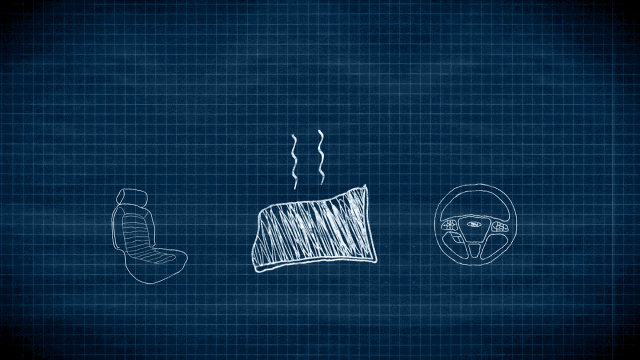A FORD MATERIALS ENGINEER TELLS US EVERYTHING WE EVER WANTED TO KNOW ABOUT DESIGNING THE FRAGRANCE OF YOUR CAR.
There are more than 100 different materials inside your average car. And they all smell like something.
The effect could be disastrous, like being trapped inside a burning latex factory while driving the family to Disney World. But instead, this gritty bouquet is a borderline legendary design feature of automobiles known as new car smell. And nothing else in the world smells quite like it.
That, of course, is a result of careful design, in which experts sniff every material that you’ll sniff inside the cabin. We spoke to Ford materials engineer Linda Schmalz to learn all about how it’s done. What she shared is a small peek at the obsession that goes into even the cheapest cars you can buy. It’s also a perfect listicle of cocktail conversation starters for future reference.

New car smell is kinda gross, if you think about it.
What we call “new car smell” is what any scientist would call “off gassing.” Newly produced industrial goods release chemicals into the air that have a discernible odor. And it actually varies quite a bit by car, depending if it’s filled with fabric, leather, or wood—and the varying adhesives used can make a big difference, too. “It does dissipate over a short period of time and it’s not renewable,” Schmalz says of the smell. “We don’t design to get the new car smell. What we design is for the materials to have a perceptible odor, but not be disturbing.”
To test odor, car components are heated and sniffed in big mason jars.
To test how a car will smell when it’s mass manufactured, Ford uses domestic-level science: mason jars and an oven. A small chunk of what’s inside your car is stuck into the jar. The jars are then stuck in an oven, and heated to three distinct temperatures: 73F to simulate standard room temperature, 104F with some water to simulate humidity, or 176F to simulate the dry heat of a car in the sun. A team of about six people rate the smells individually, and completely subjectively, flagging anything that smells bad.
It’s almost like sniffing a deconstructed model car.
Every new material Ford buys—like a new carpet or wood—is tested in these jars. But interestingly, every finished component Ford builds into your car—like a slice of your dashboard or piece of your door—is tested, too. This is because the sum of parts can create a different smell than the parts alone.
“When you have just a plastic door panel it’s a little bit more straightforward because you don’t have extra things added to it,” Schmalz says. “But when you have foam, or carpet, or an adhesive, it’s more complicated.”
Notably, these small pieces are scaled to their relative size in the car, to simulate the scale of the smell.
The smell jury is small and sort of ad hoc.
The smell testers all have other jobs most of the time. The team only consists of one manager who brings in a small group of laboratory engineers to be subjects in the smell test. And smell tests aren’t generally performed over and over.
You can’t smoke and be on the smell jury.
I was curious, just what qualified you to be on this smell jury? It doesn’t take deep training, I’m told. More important is that, “They don’t smoke, have a cold, have allergies, wear heavy perfume or cologne,” Schmalz says.
But you can’t smell too well to be on the smell jury, either.
“There are people who are really sensitive to every single smell out there, and they are a tough one to have on the jury,” Schmalz says. “Sometimes they’re a little too critical and you have to be careful.”

If something fails the smell test, the manufacturer tries again.
Any item that Ford wants to use that fails the test needs to be, somehow, reformulated. So the team circles back with the manufacturer. This is more and more rare, though, Schmaltz says, as odor quality control has improved across the industry.
“A lot of the failures we’ve been getting recently for odor, and there aren’t many anymore, are on composite,” Schmaltz says, referring to materials that have been fused with other materials. “Let’s say for a trunk, they’ve selected the carpet, they select the adhesive, and they bond it to a substrate. Sometimes when an adhesive is selected, it meets the requirements for strength, but has an objectionable odor. In that case, we go back to them. We say, ‘hey your adhesive smells, you’ve gotta come up with something else.”
Different countries smell differently.
A secret of the trade is that people from different countries will smell things differently. Schmalz doesn’t know whether the cause is genetics, environmental, or even cultural, but Ford has labs in Europe and China who assess odors, too, to make sure the smells can play internationally.
“Leather is a very tricky one,” Schmalz says. “That one is very difficult to manage [internationally]. You have to be careful that you please all regions with the odor that it gives because it’s a natural product.”
Ford can’t ship completely different interiors based upon international tastes, so instead, they attempt to find a happy medium material in the testing.

Even with all this work, things can go wrong.
Notably, there’s no stage in which a complete car interior can be smelled at once until the car is actually put into production. And so in the 11th hour, problems can still crop up.
“We do have those issues occur on occasion when a vehicle will be in an early build stage and the plants will call and say, ‘something’s not right, we have an odor issue,’” Schmalz says. “Plants are located somewhat close to us, so we go to the plant, bring a small jury with us and try to find where the odor is coming from. Sometimes we can’t narrow it down, but we can find the area of the vehicle it’s coming from, so we start doing an analysis of the components in the area it’s coming from.
“We’ve found issues where a supplier might have changed things and it wasn’t recertified. it’s not a very frequent thing that happens. but there’s always room for something not to go exactly right.”
Everything smells, so new car smell is never going away.
Even if you wanted to eliminate the smell of a new car, you couldn’t. According to Schmalz, that’s because of the hottest test, the 176F test, which will make anything smell, just like your kitchen smells when baking something in the oven. “Even if I put a piece of paper in the jar and smelled it, it would smell like hot paper,” Schmalz says. “It’s very difficult to [ever]say there’s no odor.”
[App Photo: Flickr user Scott Robinson]




